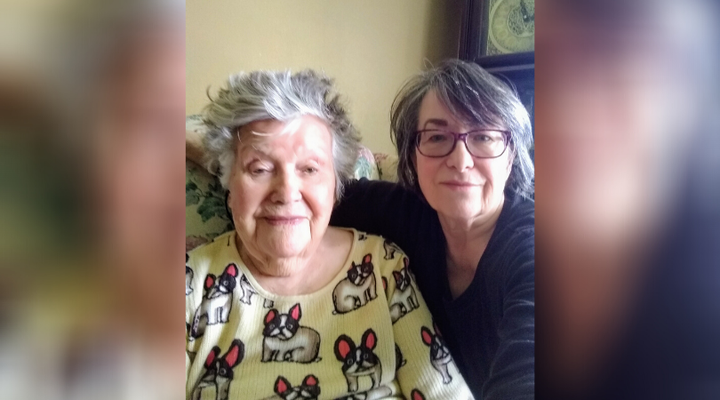Dilys Patterson made the decision to pull her mom Joan out of long-term care two days after she learned a resident in the home had tested positive for COVID-19.
She was immediately concerned the virus could spread through the building’s elevators, which residents crowded into many times a day. Her 93-year old mother was also in a room with three other residents.
Patterson was told by the home, Camilla Care Community in Mississauga, Ont., that she could take Joan out for 21 days and keep her room, or pull her out of care completely.
“I felt my mom had a better chance if I took a leave of absence and looked after her at home,” Patterson, who works in retail, told HuffPost Canada.
A spokesperson for Sienna Senior Living, which owns the home, told HuffPost that because admission and discharge policies are mandated by the Ministry of Long-Term Care, they will continue to look to the province for direction on related matters.

On April 8, Patterson moved her mom out of the long-term care home. A few hours later, she got a call saying more residents and staff had tested positive. As of June 11, the home has 68 resident deaths but is no longer in an outbreak, according to the province. It was temporarily taken over by Trillium Health Partners, a nearby hospital.
Hearing about more positive cases there reaffirmed Patterson’s decision to bring her mom home. Two months later, though, she is hoping to return to work, but her mom has dementia and needs to be supervised at all times.
“Right now, her future, as well as mine, is kind of in limbo.”
As the pandemic continues, people like Patterson have had to make tough decisions about whether to leave their loved one in a care home — and risk them contracting COVID-19 — or bring them home and risk giving up their spot in long-term care.
Patterson said her mom would be high priority to return to Camilla Care, but she doesn’t want her to go back there. She has been researching long-term care homes. She doesn’t want to put her mom back into a for-profit one because of the often-dismal conditions exposed by the pandemic. She’s looking for homes that have two-bed rooms, and that have managed the pandemic well. That has led her to municipal-run homes, but she’s not sure if her mom will be considered a high priority on the wait list for those homes.

A Toronto Star analysis found that in homes with an outbreak, residents in for-profit homes are twice as likely to contract COVID-19 and die than residents in non-profit homes, and about four times as likely to contract it and die than residents in municipal homes.
Residents who leave a long-term care home during the COVID-19 outbreak will be discharged, a spokesperson for the Ontario Ministry of Long-Term Care told HuffPost. Once their home is free from an outbreak, that residents’ re-entry would be expedited due to recent changes to the province’s legislation governing long-term care homes, Macey Aramburo said.
However, if a resident leaves a home that does not have an outbreak, they will be prioritized for readmission, but their room will not be held “because it would be irresponsible to let long-term care capacity sit vacant at a time when it is needed,” Aramburo said.
“At this unprecedented time, it is important that we enable hospitalized seniors who are on the wait list for long-term care to receive that care, both to limit their risk of exposure to COVID-19 and to free up hospital capacity.”
People will only be admitted or readmitted to homes if the facility is not experiencing a COVID-19 outbreak, the person has tested negative and moves in within 24 hours of receiving that test result and the home has a plan to ensure the person can self-isolate for 14 days.
Louise Smith, who asked to be identified by her middle name so her mother cannot be identified or face repercussions, says she was also told that if her mom left her care home for longer than 21 days, they would pack up her belongings and give the room to someone else on the wait list.
The non-profit long-term care home, Heritage Green Nursing Home, has not responded to HuffPost’s request for comment.
She brought her mom to her Hamilton, Ont. home for 21 days, beginning April 24, the day she found out her mom had tested negative. During that time, an administrator from the home informed her that all the residents and staff had tested negative. Smith felt it was safe to bring her mom back. She talks to her every day on the phone and has visited outside the fence, calling to tell her mom, who lives on the second floor, to come to the window.
Her mom is turning 88 in July and lives with Alzheimer’s and dementia. She says having her mom at home wasn’t easy; she fell twice and bruised her face, and until the third and last week she was there, she seemed confused and forgot who her daughter was.
Now Smith is worried that if there’s another outbreak at the home, she’s used up those 21 days, so she would lose her mom’s room if she brought her home again. If the pandemic ends she won’t be able to take her mom out for any reason this year.
“I do feel much better now about that, and I just pray to God it stays that way.”
- Louise Smith
“But even with [no current outbreak], you sit and you’re on pins and needles all the time, because the long-term care home, they only send out an update once a week. So you don’t know what’s happening daily,” she said.
She also worries about the safety of homes still accepting residents from the wait list. Someone coming from a hospital could potentially spread the virus to the care home. Although the government requires new residents in long-term care to isolate for 14 days, family members of residents at long-term care homes have previously told HuffPost it’s difficult to isolate in shared rooms, or when residents who have dementia wander around the home.
Only readmissions from hospitals are allowed right now, a ministry spokesperson told HuffPost. New residents admitted to long-term care can only come from the community, per a ministry directive.
Ultimately Smith says it’s a catch-22: she doesn’t want her mom to be infected or get sick, but she wishes she could see her from closer than being outside the fence.
She’s hoping that the government will implement a plan to allow family visitors so she can sit outside with her mom and chat.
“I go up there three times a week, and I can see that they are all wearing PPE and nobody’s going in and out unless you’re a nurse or a [personal support worker] or a doctor,” she said. “So I do feel much better now about that, and I just pray to God it stays that way.”